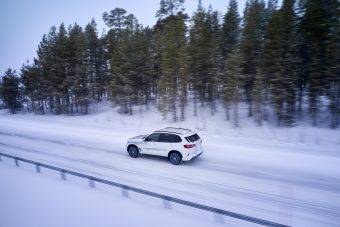
The BMW iX5 Hydrogen is currently undergoing a demanding programme of testing in extremely challenging weather conditions. It is all part of final winter testing for the car on public roads and at the BMW Group’s testing centre in Arjeplog, northern Sweden. The integrated functional testing and validation of the fuel cell system, hydrogen tanks, peak power battery and central vehicle control unit have confirmed that this additional CO2-free mobility option can also be relied on to provide sustainable driving pleasure with high levels of comfort and unrestricted performance in extreme sub-zero temperatures.
The tests close to the Arctic Circle see the BMW Group pressing ahead with its development process for the BMW iX5 Hydrogen. The company will produce a small series of the model later in the year and is also committed to helping expand the network of hydrogen fuelling stations. “The winter testing under extreme conditions clearly shows that the BMW iX5 Hydrogen can also deliver full performance in temperatures of -20°C and therefore represents a viable alternative to a vehicle powered by a battery-electric drive system,” says Frank Weber, Member of the Board of Management of BMW AG, Development. “For us to be able to offer our customers a fuel cell drive system as an attractive sustainable mobility solution, a sufficiently extensive hydrogen infrastructure also needs to be in place.”
BMW iX5 Hydrogen: hallmark BMW dynamics, range and everyday usability all year round.
In these test runs on the ice and snow around Arjeplog, the BMW iX5 Hydrogen is busy demonstrating how reliably, comfortably and powerfully its hydrogen fuel cell drive system can already meet the mobility requirements of everyday life. After racking up hundreds of sessions on test rigs and in-depth field testing on the road, this adds another chapter to its development story.
More:
The evidence is there for all to see: here, in this extreme cold, the hydrogen fuel cell drive system displays the same everyday usability as a conventional internal combustion engine. Full system power quickly comes on tap. Even in these freezing conditions, the drive system continues to offer its full operating range. And replenishing the hydrogen tanks takes only three to four minutes, even in the depths of winter. “The hydrogen fuel cell drive system combines the best of both drive worlds, regardless of the time of year and outside temperatures: it offers the locally emission-free mobility of an electric vehicle and the unrestricted everyday usability – including short refuelling stops – familiar from models with an internal combustion engine,” says Jürgen Guldner, Vice President of Hydrogen Fuel Cell Technology and Vehicle Projects at the BMW Group.

The drive system on board the BMW iX5 Hydrogen teams fuel cell technology with an electric motor using fifth-generation BMW eDrive technology. The hydrogen it uses as an energy source is stored in two 700-bar tanks made from carbon-fibre-reinforced plastic (CFRP). The fuel cell converts the hydrogen into electric power, generating output of 125 kW/170 hp. Plus, the electric motor can add the energy stored in a power battery to the mix. This battery is charged either through energy recovery or from the fuel cell. All of which means that system output of 275 kW/374 hp is available when the driver decides to explore the upper reaches of the car’s dynamic abilities. The only emission released by the fuel cell is water vapour. And its waste heat is harnessed particularly efficiently to warm the car’s interior.
Unique drive system meets all requirements.
The drive, energy storage and control systems all pass the ultimate test of endurance in the wintery surrounds of Lapland. Added to which, specially prepared ice surfaces and snow-covered roads offer the perfect conditions to test the integrated application of all the drive and chassis systems. This also encompasses the steering, springs and dampers, as well as the chassis control systems and the interplay of the friction brakes and deceleration by energy recuperation. Here again, the BMW iX5 Hydrogen is able to make its strengths count, as it also weighs less than a comparable battery-electric model.
The combination of fuel cell and peak power battery gives the BMW iX5 Hydrogen a globally unique drive system. Its technology has the potential to add another pillar to the BMW Group’s drive system portfolio for locally CO2-free mobility. BMW i – as a brand focused entirely on mobility producing zero local emissions – could in future offer vehicles with a hydrogen fuel cell drive system alongside its battery-electric models. This would allow it, most strikingly, to meet the mobility requirements of customers who do not have their own access to electric charging infrastructure, frequently travel long distances or desire a high degree of flexibility.
Source: BMW Group



